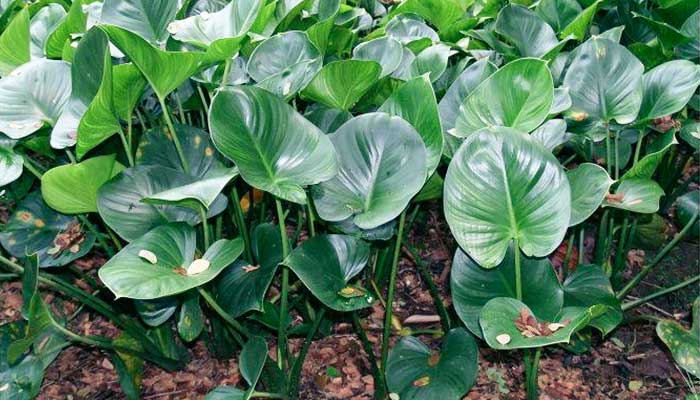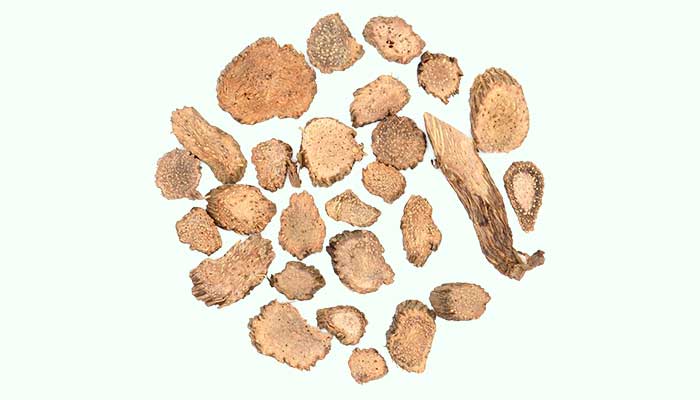What Is Qian Nian Jian
Qian Nian Jian commonly known as Rhizoma Homalomenae is the rhizome of Homalomena occulta, which is an evergreen perennial herb belonging to the family Araceae. It is a relatively practical Chinese herbal medicine, which first appeared in <Ben Cao Gang Mu Shi Yi> (a supplement to the compendium of materia medica) in the 30th year of Qianlong in the Qing Dynasty (1,765 AD).
There are about 145 species of Homalomena, which are mainly distributed in South Asia and the Southwest Pacific. Among them, some species are common tropical aquascape plants, and only some species have medicinal value.
Homalomena occulta is a shade-loving plant. They are afraid of cold, drought, and strong sunlight. They often grow in dense valleys, bamboo forests, and shrubs at an altitude of 80-1,100 meters. They are distributed in southern China and the Indo-China Peninsula.

In spring and autumn, people gather the rhizomes of Homalomena occulta, wash them with water, remove their outer skins, dry them in the sun, cut them into thick slices, and make them into Chinese herbal medicines.
Qian Nian Jian contains linalool, torreyol, α-cadinol, eugenol, terpinol, terpinene, citrene, myrcene, cembrene, α-pinene, β-pinene, geraniol, menthone, widdrene, caryophyllene, camphor, citronellic acid, linolic acid, arachidic acid, myrcenol, bullatantriol, homalomenol A-E, asperpenoid, homalomenin A-E, maristeminol, protocatechuic acid, vanillic acid, syringic acid, caffeic acid, ferulic acid, apigenin, stearic acid, β-sitosterol, β-daucosterol, stigmasterol, and polysaccharides.
Generally, yellowish-brown to reddish-brown, rough Qian Nian Jian with a reddish-brown cross-section, many yellow fiber bundles, and a strong aroma is preferred.
According to <Ben Cao Gang Mu Shi Yi>, the medicinal nature of Qian Nian Jian is relatively warm, with a bitter and pungent taste. It has a certain therapeutic effect on the pathological changes of the liver and kidney meridians.
In traditional Chinese medicine, it is often used to expel wind and dampness, strengthen tendons and bones, and treat rheumatic arthritis, rheumatoid arthritis, lumbago and skelalgia due to wind-dampness, muscular spasms, numbness of limbs, disadvantageous flexion and extension of joints, flaccid tendons and bones, osteoarthritis, cataclasis, soft tissue contusion, osteoporosis, and Alzheimer’s disease.
Benefits
- Anti-inflammation, inhibiting xylene-induced ear swelling in mice and carrageenan-induced paw swelling in rats.
- Increasing pain threshold and reducing the number of writhing in mice induced by acetic acid.
- Anti-oxidation, scavenging hydroxyl radicals.
- Inhibiting the activity of calcium channel blocker receptors and angiotensin II receptors.
- Inhibiting lipopolysaccharide-induced expression of cyclooxygenase-2 mRNA and protein in mouse macrophages, and prostaglandin E2 production.
- Inhibiting the activity of β-secretase, reducing the levels of Aβ40 and Aβ42 proteins in the brain, and improving the symptoms of Alzheimer’s disease.
- Inhibiting histamine-induced contraction of isolated guinea pig tracheal smooth muscle.
- Expelling wind and dampness, strengthening tendons and bones, treating cold pain in the waist and knees, muscular spasms, numbness of limbs, flaccid tendons and bones, and arthralgia caused by wind-damp-cold.
- Its aqueous extract has a certain inhibitory effect on the type I herpes simplex virus.
- Its sesquiterpenoids have a significant promoting effect on osteoblast proliferation and differentiation in vitro. Its chloroform extract can significantly stimulate the mineralization of cultured osteoblasts in vitro [1].
- Its volatile oil has a strong inhibitory effect on Brucella, Curvus pallidus, Aspergillus niger, Fusarium graminearum, Trichophyton rubrum, Trichophyton mentagrophytes, Microsporum gypsum, and Candida albicans.
- Studies have found that its extract has a strong inhibitory effect on the activity of matrix metalloproteinase MMP-16 in vitro.
Combinations
- It can be used in combination with Du Huo (Radix Angelicae Pubescentis), Sang Ji Sheng (Herba Taxilli), Wu Jia Pi (Cortex Acanthopanacis), etc. to treat cold pain in the waist and knees, muscular spasms, numbness of limbs, flaccid tendons and bones, and arthralgia caused by wind-damp-cold.
- It can be used in combination with Di Feng Pi (Cortex Illicii), Lao Guan Cao (Erodium stephanianum), etc. to treat the pain of tendons and bones, muscular spasms, and numbness of limbs caused by wind-cold.
- It can be used in combination with Chuan Wu (Radix Aconiti), He Shou Wu (Fo-Ti or Fleeceflower Root), Di Feng Pi (Cortex Illicii), Bai Jiu (White Liquor), etc. to treat lumbago and skelalgia caused by wind-dampness.
- It can be used in combination with Ma Chi Xian (Purslane), Chuan Xiong (Rhizoma Chuanxiong), Dan Shen (Radix et Rhizoma Salviae Miltiorrhizae), Jiang Xiang (Lignum Dalbergiae Odoriferae), Bing Pian (Borneol), etc. to relieve stuffy pain, fixed pain, abdominal distention, and frequent sighing.
- It can be used in combination with Dang Gui (Radix Angelicae Sinensis), Chuan Xiong (Rhizoma Chuanxiong), Bai Zhi (Radix Angelicae Dahuricae), Hong Hua (Flos Carthami), Chi Shao (Radix Paeoniae Rubra), Tao Ren (Semen Persicae), Bai Jiu (White Liquor), etc. to treat postpartum dizziness and fatigue, weakness and aching pain of limbs.
Side Effects
- At present, there are no reports in the literature that Qian Nian Jian has toxic effects, and there are no reports of serious adverse reactions when it is taken according to the prescribed dose.
- If you need to take it for a long time, please consult a professional doctor and formulate a reasonable medication plan.
Precautions and Warnings
- The dosage of Qian Nian Jian should be controlled at 5-10g.
- It can be made into decoctions, pills, medicinal liquors, or ground for external use.
- People who are allergic to Qian Nian Jian should not take it.
- It should not be taken at the same time as Lai Fu Zi (Radish Seed).
- Patients with internal heat due to yin deficiency should not take it.
- Pregnant and breastfeeding women should take it under the guidance of a doctor.
- The elderly and the infirm should take it under the guidance of a doctor.
